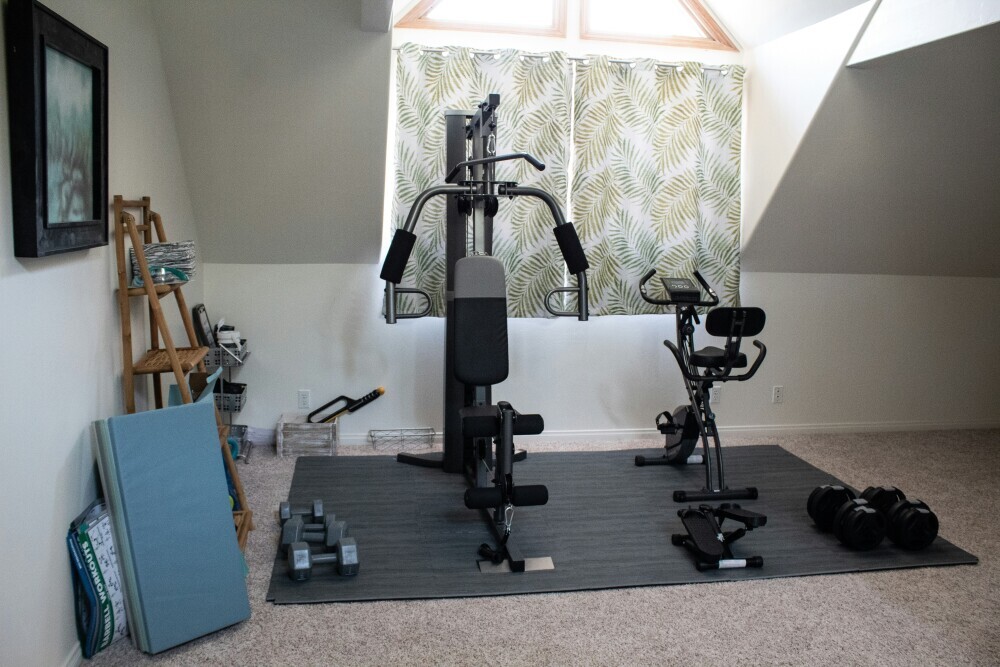
Living in a small apartment doesn’t mean you have to sacrifice your fitness goals. With a bit of creativity and strategic planning, you can transform even the tightest spaces into functional workout areas. From re-arranging furniture to finding multi-purpose equipment, there are countless ways to make the most of your living space. In this guide, we’ll explore practical solutions for setting up a home gym in a small apartment, helping you maintain an active lifestyle without compromising on comfort or style.
Evaluating Available Space: Taking Inventory – Begin by assessing the available space in your small apartment. Measure the dimensions of potential workout areas, and take note of any furniture that can be moved or re-arranged. Consider unconventional spaces such as hallways or the space beside your bed. Understanding the exact amount of room you have will guide the rest of your planning.
Dual-Purpose Furniture and Equipment – In a small apartment, every piece of furniture and equipment needs to work double duty. Look for items that can serve multiple functions like a coffee table that can convert into a bench for step-ups, or a foldable treadmill. There are plenty of smart solutions on the market that can help you maximize both your living space and workout area.
Vertical Storage Solutions – When floor space is limited, go vertical. Shelves, hooks, and wall-mounted storage units will help keep your equipment organized and off the ground. This not only saves space but also ensures your area remains neat and tidy. Hanging baskets or pegboards can hold everything from resistance bands to yoga mats, keeping your workout essentials within reach and your apartment clutter-free.
Clearing Clutter: Making the Most of Every Inch – Declutter your space regularly to make room for your workouts. Consider adopting a minimalist approach to your living area. Get rid of or store away non-essential items to create a more open environment. The less clutter you have, the easier it will be to transition your space into a functional workout area. This also helps improve mental clarity and focus during your workouts.
Budget-Friendly Essentials: What You Really Need
Prioritizing Equipment: Must-Haves vs. Nice-to-Haves – Focus on acquiring essential equipment first. Prioritize items like a yoga mat, resistance bands, and adjustable dumbbells. These pieces are versatile, affordable, and can be used for a wide range of exercises. Once you have the basics, consider adding extras like a stability ball or jump rope if your budget allows.
DIY Equipment: Homemade Solutions – Save money by creating your own workout gear. Use household items to substitute for traditional equipment. For example, water bottles can act as makeshift dumbbells, and a sturdy chair can replace a bench for step-ups and tricep dips. There are countless DIY ideas online that show you how to build effective workout tools from everyday objects.
Cost-Effective Brands and Where to Find Them – Shop around for budget-friendly brands that offer quality equipment at lower prices. Look for sales, discounts, and second-hand options. Stores like Decathlon, Walmart, or online platforms like Amazon often have affordable equipment that doesn’t compromise on quality. Keep an eye out for seasonal sales during holidays for the best deals.
Buying Second-Hand: Pros and Cons – Purchasing second-hand equipment can be a smart way to save money. Check out local classified ads, garage sales, or online marketplaces like Facebook Marketplace and Craigslist. While you can find great deals, it’s essential to inspect items thoroughly to ensure they’re in good condition. Test any moving parts, check for wear and tear, and negotiate the price to fit your budget.
Designing a Multi-Functional Workout Space
Choosing the Right Spot: Workout Zones – Designate specific areas within your small apartment for different workout activities. Identify a corner for cardio exercises, another zone for strength training, and a space for stretching and cool-downs. This segmentation helps create an organized and efficient workout environment, making it easier to switch between activities.
Incorporating Aesthetics on a Budget: DIY Decor Tips – A well-decorated workout space can boost motivation and make workouts more enjoyable. Use affordable and DIY decor solutions like posters, motivational quotes, or fabric wall hangings. Consider creating a feature wall with some budget-friendly paint or wallpaper. Small touches like these can transform the ambiance of your space without breaking the bank.
Balancing Functionality and Comfort – Your workout area should be both functional and inviting. Use cushioned mats or carpets to provide comfort during floor exercises and to protect your flooring. Ensure there’s adequate ventilation and natural light to maintain a fresh and energizing atmosphere. Adding a few houseplants can enhance the overall vibe and make the space feel more lively.
Lighting and Mirrors: Creating an Inviting Atmosphere – Proper lighting is crucial for a good workout experience. Introduce bright, adjustable lighting to ensure your space is well-lit during exercise sessions. Incorporating mirrors can create an illusion of a larger space while also allowing you to check your form. Mirrors also reflect light, making the area feel brighter and more open.
Efficient Workouts for Limited Space
Best Exercises for Small Areas – Choose exercises that require minimal movement and space. Bodyweight exercises such as squats, lunges, push-ups, and planks are highly effective. High-intensity interval training (HIIT) routines can also be done in small areas and provide an intense workout in a short time.
Utilizing Compact and Versatile Equipment – Opt for equipment that is compact and can be used in various ways. Resistance bands, kettlebells, and foldable exercise bikes or ellipticals can offer a thorough workout without taking up valuable space. These items are easy to store and can be quickly set up for use.
Circuit Training: High-Intensity in Small Spaces – Design circuit training routines that make the most of your small space. Include exercises such as burpees, mountain climbers, and jumping jacks mixed with strength training moves. These routines keep your workout dynamic and effective without needing a large area.
Space-Saving Exercise Routines – Create custom workout plans that fit your specific space constraints. Consider routines that include standing exercises, wall exercises, and floor work that doesn’t require extensive movement. Apps and online resources offer numerous space-saving workout plans tailored for small living areas.
Maintaining Your Home Workout Space
Cleaning and Organizing Tips – Keeping your workout area clean and organized helps maintain a positive and motivating environment. Wipe down equipment regularly to prevent dust build-up and sweat stains. Use storage solutions like bins or baskets to keep small items like resistance bands and hand weights in place when not in use.
Regularly Updating Your Setup: Adapting to New Needs – As your fitness routine evolves, so should your space. Regularly assess your setup to see if it meets your current needs. Swap out equipment that you no longer use, or reconfigure your layout to accommodate new exercises. Adaptability is key to keeping your workout space functional and inspiring.
Top Apps and Online Resources for Home Workouts – Leverage technology to enhance your home workouts. Numerous apps offer guided workout routines, fitness tracking, and even virtual trainer sessions. Websites and online communities also provide platforms for sharing ideas and finding new routines that fit your space constraints.
Staying Motivated: Creating a Routine and Setting Goals – Consistency is vital for any fitness journey. Establish a workout schedule that fits into your daily life and set achievable goals to keep yourself motivated. Use a calendar or planner to track your progress, and celebrate small victories to maintain a positive mindset.
As you can see, creating an efficient and motivating workout space in a small apartment is entirely possible with the right approach. By evaluating your available space, investing in versatile equipment, and adopting smart storage solutions, you can build a functional home gym that fits seamlessly into your living environment. With a little organization and thoughtful design, your compact space can support your fitness routine and inspire you to stay on track with your goals.

This guide offers clever, budget-friendly ideas for creating a home workout space in a small apartment. I like how it covers evaluating available space and using multi-functional furniture – like converting coffee tables into step-up benches. The tips on DIY equipment and buying second-hand are also helpful, making fitness accessible without breaking the bank.
Suggestions for vertical storage and decluttering are practical for keeping spaces organized and motivating. The idea of setting up distinct workout zones and using mirrors and good lighting to improve the workout atmosphere is smart, making even the smallest areas feel functional. Overall, a handy resource for staying fit at home, no matter the space or budget constraints.
Thanks, Shambles! Glad you appreciated the post and thanks for offering your thoughts on the topic!
Mark
Great tips! My personal favorite suggestion for people with space limitations is to find an airbike for HIIT workouts. An airbike doesn’t take up much space, it provides cardio and an upper body workout. In my area, Facebook market place is an excellent place to find used equipment at great prices.
That’s a great point! I’ve never used one myself, but wouldn’t mind getting one. Great suggestion!
Mark
Hey there! I just wanted to swing by and say how helpful your guide on setting up a budget-friendly home workout space was—loved the way you suggest repurposing household items as free weights and adding mirrors to check form. It felt like advice from a friend who’s been there, not some generic list. Quick question: when you found old furniture doubled as exercise tools, did you ever worry about stability or safety? And I’m curious—what’s your favorite DIY free-weight hack that consistently surprises you with its effectiveness?
Glad you enjoyed the article! I would say to just use your own judgement with old benches and other furniture you might consider working out on. It’s always great to find new uses for that stuff, but not if it creaks too much or doesn’t seem like it would support your weight PLUS whatever weights you might be utilizing to work out.
Mark